Environmental microbiomes
1/46
There's no tags or description
Looks like no tags are added yet.
Name | Mastery | Learn | Test | Matching | Spaced |
|---|
No study sessions yet.
47 Terms
Unique Microbial Metabolism
Microbes can use nearly any molecule in nature as a source of carbon or energy allowing them to occupy diverse eco niches.
Cornelius van Niel
Recognized that every molecule in nature can be used by microorganisms as a source of carbon or energy.
Marine/aquatic microbes
Bacteria and algae serve as primary producers, forming the base of food webs in both marine and freshwater ecosystems.
Structure of Marien habitat
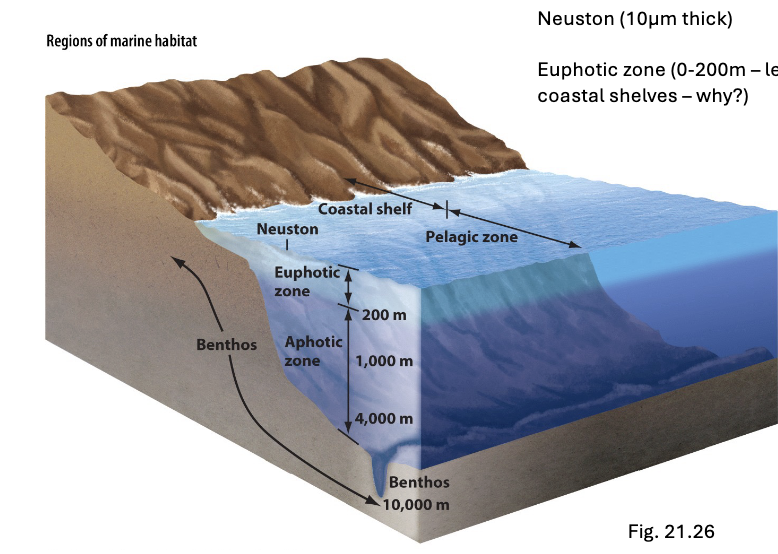
Neuston
A very thin layer (approximately 10μm thick) at the ocean surface, where microbial life is abundant.
Euphotic Zone
The upper layer of the ocean (0-200 meters deep), where sunlight penetrates and supports photosynthetic activity.
The depth of the euphotic zone decreases in coastal shelves due to factors like turbidity (particles in water) blocking light penetration.
Which region contains the highest concentration of microbes in marine ecosystems?
The euphotic zone is likely to contain the highest concentration of microbes, as it supports photosynthetic activity and a wide variety of microbial life.
Holger Jannasch
Renowned microbiologist who discovered unculturable marine bacteria.
Discovered that decomposition of materials in the ocean takes up to 100 times longer than on land.
many marine bacteria could be seen under the microscope but could not be cultured on traditional lab plates which led to the realization that many marine microbes are oligotrophic, thriving in low-nutrient environments.
True or false most ocean microbes are oligotrophic
True - they thrive in environments with low nutrients
Alvin Submarine Incident
In October 1968, the Alvin submarine sank after an accident during deployment.
It remained around 1500 meters deep for nearly one year before being recovered.
During the recovery of Alvin, a lunchbox was found aboard.
This unexpected discovery provided an opportunity for research, highlighting the resilience of microbes in deep-sea environments.
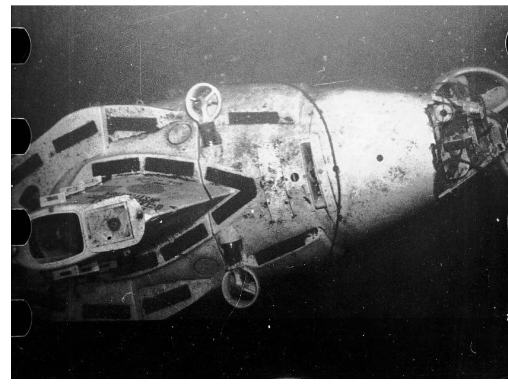
Sorcerer II Global Ocean Sampling Expedition
this expedition aimed to sample and map microbial life in the world's oceans.
The expedition found that 25,000 different microbial species can be found in just one liter of seawater.
70% of these species were previously unknown to science.
In a single drop of seawater there are:
In just one milliliter of seawater, there are:
10 million viruses
1 million bacteria
About 1,000 small protists
Tara Oceans and Tara Pacific
Multi-national projects that systematically collect samples across all major oceans.
Created the Ocean Microbiomics Database, which is free to search for metagenome-associated genomes and uncover new discoveries.
Major Findings:
Temperature is the main determinant of microbiome composition in upper ocean layers.
Mutualism in the Ocean Microbiome example: Prochlorococcus and Alteromonas
Prochlorococcus marinus: The most abundant bacterial genus on Earth, responsible for half of the ocean's photosynthesis.
It forms a symbiotic relationship with Alteromonas, which produces catalase to remove H₂O₂, a toxic by-product of Prochlorococcus' photosynthesis.
Prochlorococcus has lost the ability to make its own catalase, leading to a smaller genome and faster growth.
Climate impact: Rising CO₂ concentrations may reduce Alteromonas catalase expression, harming this mutualistic relationship.
Benthos
microcrobial community living on the ocean floor, often in extreme conditions such as high pressure, cold temperatures, and low nutrient availability.
Includes (very slow metabolic rates + high concentration of heavy metal resistance genes)
barophiles
psychrophiles
oligotrophs.
Barophiles
Microorganisms that thrive under extreme pressure, typically found on the ocean floor in deep ocean environments.
Psychrophiles
Microorganisms that grow best in cold environments, such as the deep ocean floor, where temperatures are often near freezing.
Oligotrophs
Microorganisms that thrive in nutrient-depleted environments, such as the deep ocean, where nutrients are scarce.
Marine Snow
rganic material that falls from the upper ocean layers to the deep ocean, serving as a major food source for deep-sea organisms. Its abundance decreases with depth.
Hydrothermal Vents
Underwater oases where tectonic activity causes water to seep into the Earth’s crust, heat up, and release metals and ions. These vents support unique microbes that use hydrogen sulfide for energy.
so much life around here like shrimp and worms, which is possible due to microbes
high pressure and high heat.

Chemosynthesis
Process by which microbes at hydrothermal vents convert hydrogen sulfide into organic matter, serving as the foundation of the ecosystem and supporting organisms like shrimp and worms.
Life without sunlight
Hydrothermal vent ecosystems are the first known ecosystems where life exists without relying on sunlight, instead using chemical energy from the environment.
Are all undersea oases hot?
No,
Cool undersea oases include:
cold seeps
whale falls
shiprecks
Cold Seeps
Areas on the ocean floor where methane and other hydrocarbons seep out, providing an energy source for microbes and supporting unique ecosystems in the deep ocean.
Whale Fall
The remains of a whale that has sunk to the ocean floor, providing a rich, long-lasting source of nutrients for deep-sea organisms. This can sustain life for decades.
Shipwrecks
Sunken ships can become an undersea oasis, providing a long-term source of carbon and nutrients to support microbial life and other deep-sea organisms.
Soil microbiome
Soil is a mix of decaying organic and mineral matter, serving as a life support system for microbiomes and plants.
divided into horizons
Topsoil: Rich in decaying organic matter, home to slime molds and actinomycetes.
Aerated horizon: Oxygen-rich but mineral-depleted, home to fungi.
Deep layers: More anaerobic as you approach the water table, populated by prokaryotes like chemolithotrophs.
Bedrock: Few microbes, but methanogens (archaea) can be found in deeper, anaerobic conditions.
As you move down the soil what happens?
the more anaerobic it gets until you reach the water table - which forces the soil to be more anaerobic this is where we fund mostly prokaryotes - chemolithotrophs
As we reach bedrock we see less microbes and we can see methanogens (archeal).
chemolithotrophs
rock eaters that obtain minerals as electron sources to drive energy acquisition
What are the most abundant microbiomes in terms of microbial diversity?
Soil microbiome
Human Gut microbiome
D- reason is that we are disturbing the natural balance of the food webs and change the components in the microbiome.
Soil you undies challange
If u bary cotton underwear then leave them for three months. If they look the same as when u put it in- soil is not healthy and if it is broken down - soil is healthy! Because it will decay organic matter like cellulose in cotton.
Soil particle
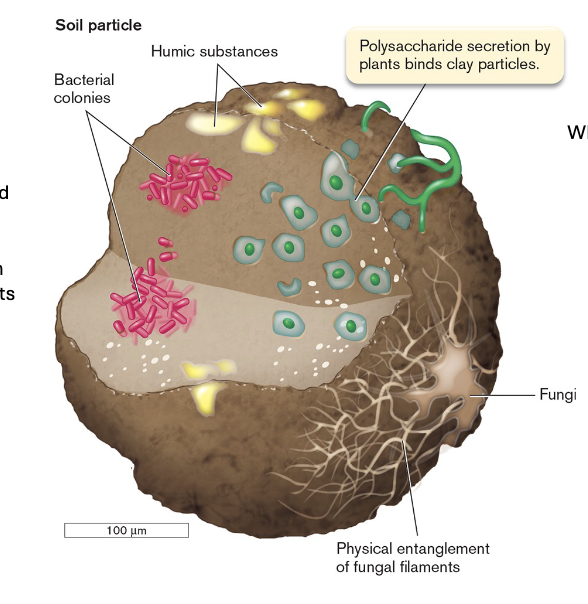
Each particle of soil supports a large number of microbes that interact witg each other and plant roots
humus
Humus: A complex mixture of partially degraded humic acids and decaying organic matter.
Role: Serves as food for soil microbes, supporting microbial activity and enriching
Why do plants need microbes?
microbes can extend their root systems so that they can pick up nutrients for them. Plant roots will recruit microbes.
What causes the smell when it rains?
streptomyces soil bacteria
Rhizosphere
The soil region around plant roots, rich in microbial activity.
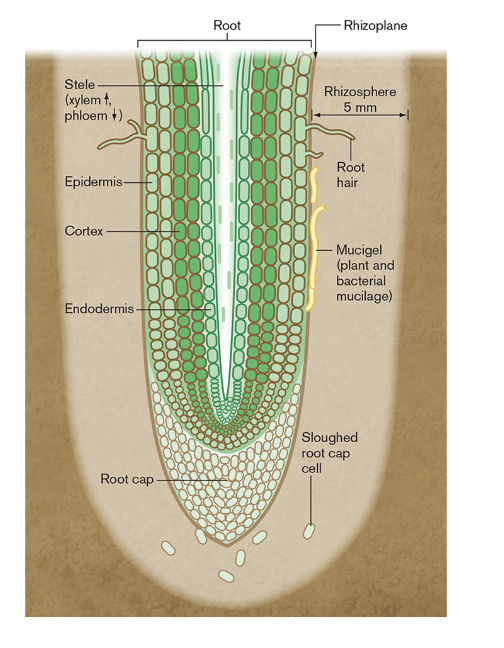
Diazotrophs
Microbes that fix nitrogen in the rhizosphere.
Microbes in the rhizosphere and plant interactions
Microbes in the rhizosphere protect plants from pathogens and help fix nitrogen.
Ectomycorrhizae
Fungi that form a protective mantle around plant roots, aiding nutrient absorption.
help plants access more nutrients from the soil, maximizing growth.
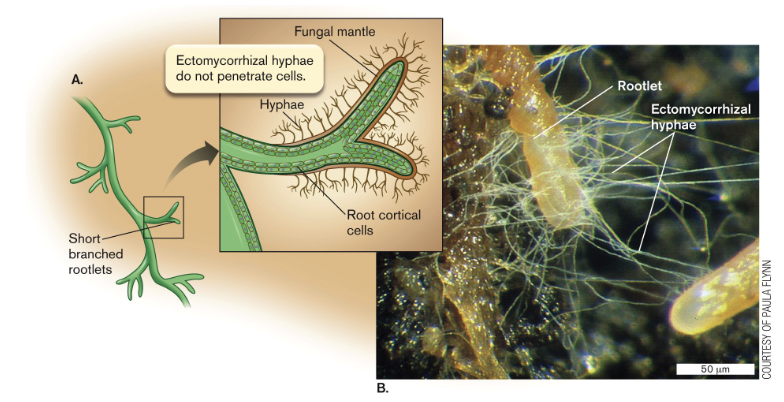
Ecto-
outside
Endomycorrhizae
Fungi that invade root cells and form arbuscules, facilitating nutrient exchange.
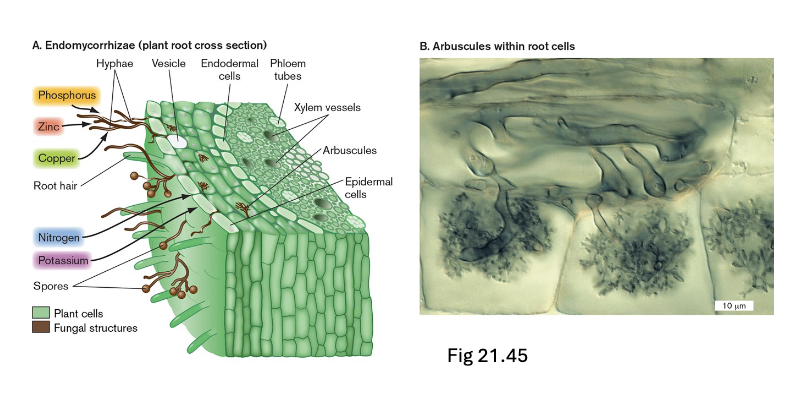
Endomycorrhizae characteristics
dependent on their plant hosts
lack sexual cycles
and exist underground.
Endophytes
Microorganisms (bacterial or fungal) that grow within plant tissues, often in a symbiotic relationship.
Rhizobia
bacteria that form a symbiotic relationship with plant roots, aiding in nitrogen fixation.
Rhizobia adapt to life within root nodules, forming a nitrogen-fixing organ for the host plant.
Why are root nodules pink?
They are pink because leghemoglobin, produced by the plant, binds to oxygen and maintains an ideal environment for nitrogen fixation.